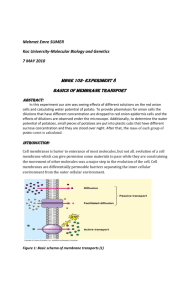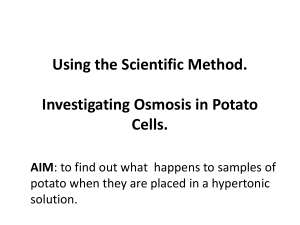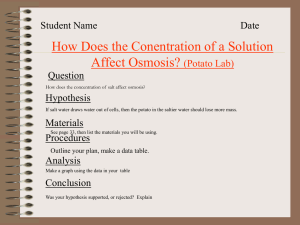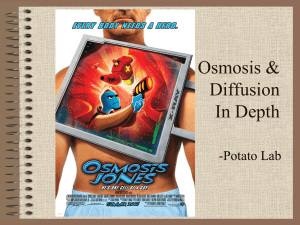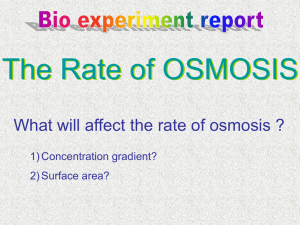potato lab - MrsGorukhomework
advertisement
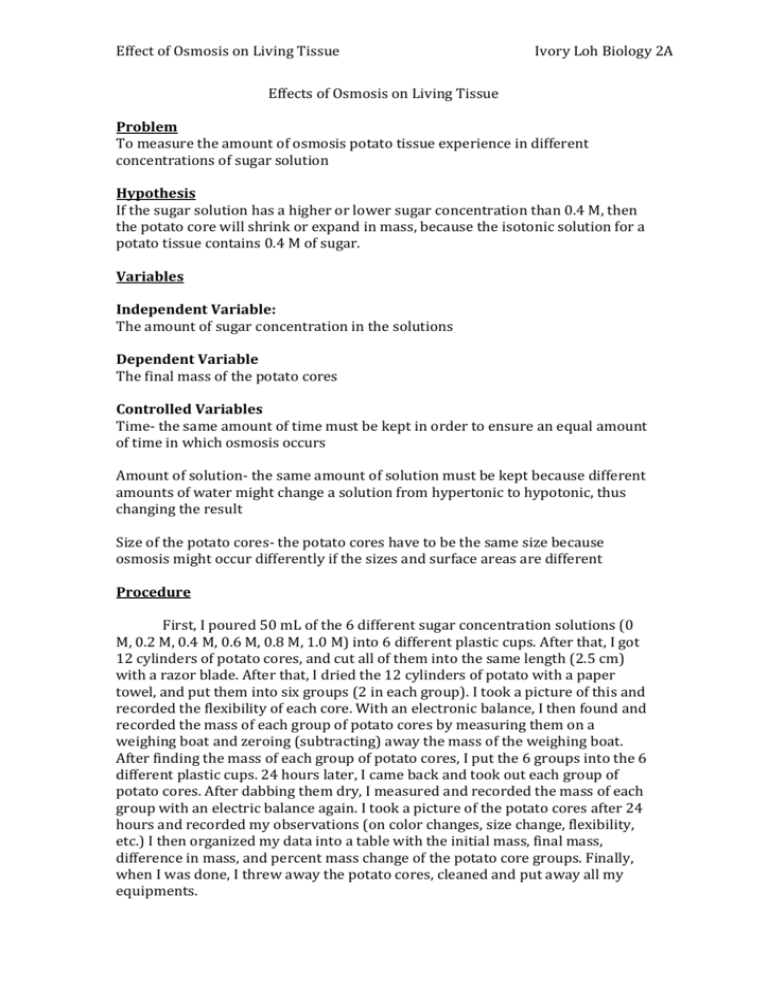
Effect of Osmosis on Living Tissue Ivory Loh Biology 2A Effects of Osmosis on Living Tissue Problem To measure the amount of osmosis potato tissue experience in different concentrations of sugar solution Hypothesis If the sugar solution has a higher or lower sugar concentration than 0.4 M, then the potato core will shrink or expand in mass, because the isotonic solution for a potato tissue contains 0.4 M of sugar. Variables Independent Variable: The amount of sugar concentration in the solutions Dependent Variable The final mass of the potato cores Controlled Variables Time- the same amount of time must be kept in order to ensure an equal amount of time in which osmosis occurs Amount of solution- the same amount of solution must be kept because different amounts of water might change a solution from hypertonic to hypotonic, thus changing the result Size of the potato cores- the potato cores have to be the same size because osmosis might occur differently if the sizes and surface areas are different Procedure First, I poured 50 mL of the 6 different sugar concentration solutions (0 M, 0.2 M, 0.4 M, 0.6 M, 0.8 M, 1.0 M) into 6 different plastic cups. After that, I got 12 cylinders of potato cores, and cut all of them into the same length (2.5 cm) with a razor blade. After that, I dried the 12 cylinders of potato with a paper towel, and put them into six groups (2 in each group). I took a picture of this and recorded the flexibility of each core. With an electronic balance, I then found and recorded the mass of each group of potato cores by measuring them on a weighing boat and zeroing (subtracting) away the mass of the weighing boat. After finding the mass of each group of potato cores, I put the 6 groups into the 6 different plastic cups. 24 hours later, I came back and took out each group of potato cores. After dabbing them dry, I measured and recorded the mass of each group with an electric balance again. I took a picture of the potato cores after 24 hours and recorded my observations (on color changes, size change, flexibility, etc.) I then organized my data into a table with the initial mass, final mass, difference in mass, and percent mass change of the potato core groups. Finally, when I was done, I threw away the potato cores, cleaned and put away all my equipments. Effect of Osmosis on Living Tissue Ivory Loh Biology 2A Effect of Osmosis on Living Tissue Ivory Loh Biology 2A Data Collection The Change in Potato Masses in Different Glucose Concentrations Glucose concentration (M) 0.0 0.2 0.4 0.6 0.8 1.0 Initial Mass (±0.01g) 1.07 1.09 1.08 1.08 1.07 1.10 Final Mass (±0.01g) Difference (±0.01g) 1.24 1.28 1.06 0.83 0.77 0.67 0.17 0.19 -0.02 -0.25 -0.30 -0.43 Percent Mass Change (%) 15.89 17.43 -1.85 -23.15 -28.04 -39.10 Formula to find the difference: Final mass - Initial mass eg. 1.24g 1.07g = 0.17g Difference = 0.17g Formula to find the Percent Mass Change: ((Final mass - Initial Mass) / Initial mass) x 100 eg. ((1.24 - 1.07) / 1.07) x 100 => (0.17 / 1.07) x 100 => ≈0.1589 x 100 => 15.89% Observations: Note: Flexibility Scale= 1 (not flexible) to 5 (very flexible) Before the experiment, all of the potato cores had about the same flexibility. It was somewhat flexible, but I couldn’t really bend it all the way. Flexibility of all the potato cores before the experiment = 2 Note: Group 1 = 0 M of sugar concentration Group 2 = 0.2 M of sugar concentration Group 3 = 0.4 M of sugar concentration Group 4 = 0.6 M of sugar concentration Group 5 = 0.8 M of sugar concentration Group 6 = 1.0 M of sugar concentration Effect of Osmosis on Living Tissue Ivory Loh Biology 2A After 24 hours, I noticed other changes, besides from the increase or decrease in mass, in the different groups of potato cores. Group 1 – The potato cores became more fragile and it was much easier to break than before. The color also became paler. When I pressed it, it was also very hard and less squishy than before. Flexibility = 1.5 Group 2 – The potato cores in this group was very similar to the potato cores in the 1st group. It also became very brittle, although it was less hard than the potato cores in the 1st group. The color became lighter than before, but it was slightly darker than the potato cores in the 1st group. Flexibility = 1.5 Group 3 – The potato cores in this group was around the same flexibility as how it was before it was soaked in the solution for 24 hours. However, it became slightly more bendable and less easy to break than before. When I pressed it, the potato cores were somewhat hard. Flexibility = 2.5 Effect of Osmosis on Living Tissue Ivory Loh Biology 2A Group 4 – The potato cores in this group was about the same color as how it was at the start. However, when I fully bent the potato core, it did not break. Additionally, the potato core became slightly softer than before. Flexibility = 3 Group 5 – The potato cores in this group became very flexible. It can be turned and twisted in almost all directions. Its color also became somewhat darker and softer than before. Flexibility = 4 Effect of Osmosis on Living Tissue Ivory Loh Biology 2A Group 6 – The potato cores in this group became extremely flexible. It could be completely twisted and bent in all directions and ways. I easily made an “s” shape with the potato core, and it stayed like that until I remodeled it. The potato core became extremely soft and was not brittle at all. Furthermore, the color of the potato cores got darker and was a lot darker than the pale potato cores from the first group. Flexibility = 5 Data Analysis Change in Potato Mass in Different Glucose Concentrations 0.3 Change in Mass (g) 0.2 0.1 0 -0.1 0 0.2 0.4 0.6 0.8 -0.2 -0.3 -0.4 -0.5 Glucose Concentration (M) 1 1.2 Effect of Osmosis on Living Tissue Ivory Loh Biology 2A Percent Mass Change (%) Percent Potato Mass Change in Different Glucose Concentrations 30 20 10 0 -10 0 0.2 0.4 0.6 0.8 1 1.2 -20 -30 -40 -50 Glucose Concentration (M) Both of these graphs show a negative relationship. In the first graph, it means that when the glucose concentration increases, that change in mass of the potato cores decreases. In the second graph, it means that when the glucose concentration in the solutions increase, the percent mass change also decreases. In addition, in both of these graphs, the data for Group 2 (0.2 M glucose concentration) is an outlier. This is because I didn’t shake the bottle before I poured the 0.2 M glucose concentration solution into the plastic cup like I did with the other solutions. This caused the data to be slightly different to what it should have been if it was following the trend line.

